Hunza Valley
Hunza was a princely state, bordering China to the north-east and Pamir to its north-west, which continued to survive until 1974, when it was finally dissolved by Zulfikar Ali Bhutto. The state bordered the Gilgit Agency to the south, the former princely state of Nagar to the east. The state capital was the town of Baltit (also known as Karimabad) and its old settlement is Ganish Village.
Situated at an elevation of 2,438 meters, Hunza Valley's tourist season is from May to October. The temperature in May is maximum 27°C and minimum 14°C. The October temperatures are: maximum 10°C and minimum 0°C.
Regions
Hunza Valley is divided into three regions.
Upper Hunza
Upper Hunza (Gojal) is beautiful valley of Hunza, and one of its sub region where there are three different linguistic groups. Burushaski speakers originated from central Hunza and migrated during kingdom of Ayashoo and Wakhi speakers oriented from Wakhan corridor. 65% of population encompass of Wakhi speakers and rest of 34% composed of Burushaski speakers. The third dialect, Domki, is spoken by 1% of the population found in Nazim abad and Shishkat village.
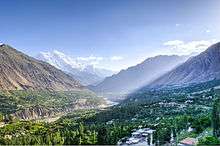
The upper Hunza starts from Ayean Abad village, nowadays affected with natural hit (Atta Abad Disaster) and sunk completely in artificial lake; Upper Hunza extends to Misgar, Shimshaal and Chuporson, (Border areas). Gulmit village is capital city of upper Hunza, and Sost is important village for commercial purposes due to Sost dry port. Upper Hunza is sub divided into four regions, as Gojal1, 2, 3, 4 respectively. Gojal one composed of Ayean Abad, Shishkat, Gulmit,Ghulkin Passu, Hussaini. Gojal two composed of Khyber, Galapan Murokhoon, Jamal Abad, Gircha, Nazimabad, Hussain Abad, Sost, Khudabad and Misgar. Gojal 3 composed of Shimshaal and finally Gojal 4 composed of Khair Abad, Rashit, Kirming, Kill, Espangi, Shersaabz, and Zodokhon.
The KKH runs from this region of Hunza and exit to neighbouring country China, at Khunjareb pass area of upper Hunza. From Chopurson the Wakhan corridor opens and this piece of land isolates this region from the former USSR.
Centre Hunza
Centre Hunza remained the administrative region during monarchical rule of Ayashoo dynast, a ruling family of Hunza for 980 years from 996-1974 and in realistic way centre Hunza is capital centre of Hunza State. Scholars disagree about the origin of families in the Centre Hunza.
Centre Hunza starts from a beautiful village Murtaza abad and ends at Attaabad and includes the villages of Murtaza abad, Hassan abad, Ali abad, Dorkhan, Shiras, Garelth, Hyder abad, Ganish, Karim Abad (Baltit), Momin Abad, Altit, Ahmed Abad, Gama Sareth and Atta abad.
This is most populous sub region of Hunza; 97% people speak Burushaski and rest of 3% speaks Domki. The Buroshoo Hunzai families everywhere on the globe oriented from this region. The diversify families roots found in Baltit, Altit and Ganish. The main families of Baltit are Diramiting, Khurokutz, Barataling, and Boroung, the main families of Altit are Hussenkutz, Hakalkutz, Khunukutz and Shu-shuroting, and the main families of Ganish are Shuknoting, Chaboekutz, Barchating and Chil Ganishkutz. The 3% Domki families settled in Momin abad, and found in minor ratio in some villages of Hunza.
Lower Hunza
Lower Hunza is a sub region of Hunza, boundaries with Nagar valley on east and on south. It starts from a village Khizir abad and ends at Nasir Abad, Lower Hunza composed of Khizir abad, Mayoon, Hussainabad, Khana Abad and Nasirabad. Nasirabad location on KKH makes it as a centre village of Lower Hunza.
This area is composed of Shina speakers, mainly migrants from nearby areas of Hunza, and many families belong to families of centre Hunza. The Shina language is the dominant language.
The main occasions celebrations are Novroz, Ginani, and Salgirahs, on these occasions delicious food traditional touch manufacture in the region, especially Sharbat and Harisa.
The region is famous for mulberry and high quality grapes, and also produces apricots, plums, cherries and other fruits. People grow maize, wheat, peas and vegetables.
KKH enter into the region on the first bridge of Hunza, at Nasirabad (Hindi) from Nagar Valley.
Cities and villages
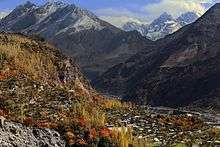
- 🌍 Karimabad , the capital of Hunza, offers an awe-inspiring view of Rakaposhi (7,788 meters). The snows of Rakaposhi glitter in the moonlight, producing an atmosphere at once ethereal and sublime.
- Aliabad
- Ganish Village – the oldest village in Hunza, with 800-year-old mosques, it was honored by UNESCO in 2002 and 2009.
- 🌍 Gulmit
- Ghulkin
- Nasir Abad
- Passu
- Sost
- Khuda Abad
Other destinations
- 🌍 Karakoram Range mountain peaks, including Hunza Peak, Ulter Peak or Ultar Peak, Bublimoting or Lady Finger.
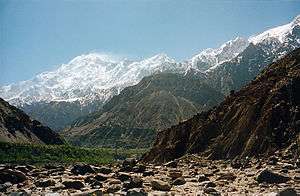
Understand
The fair-skinned and light-eyed Hunzakuts claim to be descendants of soldiers lost from Alexander's army as he invaded India, although genetic studies have disproved the claim. The language, Burushaski, provides linguists an enigma as it is unrelated to any other language known to man.

The beauty of this mountain paradise is matchless; from the soft blossoms of the apricot trees to the dark snowcapped rock monuments of Rakaposhi (7788 m), Ultar Peak (7388 m) jabbing a vivid blue backdrop high above, and Bublimoting Peak.
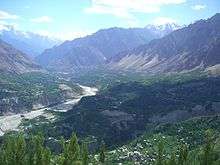
Rakaposhi is the name of a high Karakoram mountain massif and the huge pyramid peak which tops this massif. The mountain dominates the Hunza Valley west of K2, its steep ice-covered peak towering above barren cliffs and terraces. Rakaposhi's climate is generally more favorable than that of the Himalayas, as it is located far enough west to be only minimally affected by the monsoon in July and August. In fact, long periods of exceptional weather are not uncommon throughout the summer.
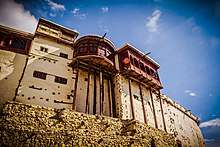
Hunza Peak lies in the Karakoram range along with the Lady Finger (Bublimoting). It lies on the southwest ridge of the Ultar Peak massif, the most southeasterly of the major groups of the Batura Muztagh. The whole massif rises above the Hunza Valley to the southeast.
This peak has at least two known routes, both climbed in 1991. Both routes where done in alpine style, the first by a Swedish expedition and the second by a British team, which included Caradog Jones and Mick Fowler.
Most of the people of Hunza are Islmaili Muslims, followers of His highness the Aga Khan.
Hunza was an independent principality for more than 900 years. The British gained control of Hunza and the neighbouring valley of Nagar between 1889 and 1892 followed by a military engagement of severe intensity. The then Thom (Prince) Mir Safdar Ali Khan of Hunza fled to Kashghar in China and sought what can be called political asylum.
The ruling family of Hunza is called Ayeshe (heavenly), from the following circumstance. The two states of Hunza and Nagar were formerly one, ruled by a branch of the Shahreis, the ruling family of Gilgit, whose seat of government was Nagar. Tradition relates that Mayroo Khan, apparently the first Muslim Thum ofNagar some 200 years after the introduction of the religion of Islam to Gilgit, married a daughter of Trakhan of Gilgit, who bore him twin sons named Moghlot and Girkis. From the former the present ruling family of Nager is descended. The twins are said to have shown hostility to one another from birth. Their father seeing this and unable to settle the question of succession, divided his state between them, giving to Girkis the north, and to Moghlot the south, bank of the river.
The visitors to Hunza are overwhelmed by the rugged charm, the fragrant breeze singing through graceful poplar trees and the velvet-like green carpet of wheat fields, set against the background of snow-covered mountains.
Get in
Via the Karakoram Highway (KKH).
Hunza is a 100 km drive from Gilgit, and most people arrive by road and it takes almost 2-3 hours to reach Hunza from Gilgit. The main bus stand is on the KKH Aliabad. There are booking agents in town for long distance buses & jeeps along the KKH. The journey from Islamabad can take as long as 24 hours.
From Kashgar (China) there is a regular international bus service to Hunza via Sost crossing over the Khunjerab Pass (about 5000 m high). Across river Hunza at Sost, there is a village called Khuda Abad. People usually do not stop at Khunjerab Pass, they just carry on their journey to Sost with the bus. From Sost, you can do a number of activities around like trekking in the valleys, or drive to Hunza-Karimabad (2 hours), where the Baltit Fort is standing. The Khunjerab Pass is open from May 1st to Dec 30th, but closed in winter.
The international bus waits until there are enough people, which can take days as of 2012. An alternative option is to take a first bus to Tashkurgan, stay at Tashkurgan one night, the next morning go to the immigration to get a departure approval, and then take a second bus to Sost, then another one to Hunza.
Get around
Private vehicles are normally used as local transport. Renting jeeps is also a common way of moving around. You can go to nearby cities on buses and by air.
See
Hunza is one of the most exotic places in Pakistan. Several high peaks rise above 6,000 m in the surroundings of Hunza valley. The valley provides spectacular views of some of the most beautiful and magnificent mountains of the world which include Rakaposhi 7,788 m (25,551 ft), Ultar Sar 7,388 m (24,239 ft), Bojahagur Duanasir II 7,329 m (24,045 ft), Ghenta Peak 7,090 m (15,631 ft), Hunza Peak 6,270 m (20,571 ft), Darmyani Peak 6,090 m (19,980 ft), and Bublimating (Ladyfinger Peak) 6,000 m (19,685 ft).
- The fairy-tale like castle of Baltit, above Karimabad, is a Hanza landmark built about 600 years ago. Stilted on massive legs, its wooden bay windows look out over the valley. It was used the resistance of the Mirs (the title of the former rulers) of Hunza.
- Hunza Valley is also host to the ancient watch towers in Ganish , Baltit Fort and Altit Fort. Watch towers are located in heart of Ganish Village, Baltit Fort stands on top of Karimabad whereas Altit Fort lies at the bottom of the valley. Dating back to 8th century CE, a huge Buddha figure surrounded by small Buddhisatvas is carved on a rock. Pre-historic men and animal figures are carved on rocks along the valley. Borith Lake is located in upper Hunza and Rush Lake is located near Nagar.
- The valley is popularly believed to be the inspiration for the mythical valley of Shangri-la in James Hilton's 1933 novel Lost Horizon. As one travels up on the Karakoram Highway, the beautiful sceneries keep on revealing themselves.
- On the way one can witness the 65 km long Batura glacier, the second longest in Pakistan, surround by Shishper, Batura and Kumpirdior peaks. On reaching Sost one can continue the journey up to Khunzhrav or turn west to witness the mystic beauty of Chipursan (also Chapursan) valley. Chipursan valley has some of most exotic tourist spots in the area. In Yarzerech (also Yarzirich) you can have a look at the majestic Kundahill peak (6000 m), or trek along the Rishepzhurav to the Kundahill to experience the soothing sceneries. Beyond Yarzerech you can travel further to Lupghar, Raminj, Reshit, Yishkuk up to Bobo Ghundi (Oston), the shrine of Baba-e-Ghund, a saint from Afghanistan near the border between Pakistan and Wakhan region of Afghanistan.
Do
- Camping
- Swimming
- Hunting
- Hiking and Trekking
- Mountaineering
- Mountain Biking
- Horse riding
- Eco tours
- Skiing
- Safari tours
- Fishing
- Shopping
- Gliding
Eat
Sleep
Go next
- To China, the bus service (NATCO & PTDC) is scheduled to begin crossing the border from Sost, Gilgit-Baltistan, to Tashkurgun, China, every day at 9AM in summers and In autumn it depends on the passengers, if the bus is full with passengers then it will leave, in case of lack of passengers it takes days to get into China.
- To Islamabad, via the Karakoram Highway. There are many buses leaving for Islamabad every day from Aliabad Hunza and Gilgit.
- To Gilgit, via the Karakoram Highway. Mini buses leaves for Gilgit in every 30 minutes from Aliabad.